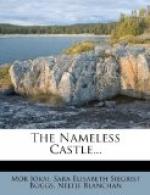“Do they pray to a different God from ours?”
“No; they pray to the same God.”
“Then why should n’t we all go to the same church?”
Unable longer to control himself, Ludwig took the shrewd little child-head between his hands, and said tenderly:
“My darling! my little queen! not all the synods of the four quarters of the globe could answer thy questions—let alone this poor forgotten soldier!”
“There! thou always pretendest to be stupid when I want to borrow a little bit of thy wisdom. Thou art like the rich man who tells the beggar that he has no money. By the way, I must not forget that I always send money to the poor children on my birthday. Come, tell me which of the heaps I shall send to-day—these small coins, or these large ones? If thou thinkest I ought to send these little yellow ones, I have no objections. I think I prefer to keep the white coins, they have such a musical sound; besides, they have the image of the Virgin. If thou thinkest I ought to send some of the large red ones, too, I will do so.”
The “little yellow ones” were gold sovereigns; the “white coins” were silver Zwanziger; and the “large red ones” were copper medals of the Austrian minister of finance, worth half a guilder.
“We will send some of the small coins and some of the large ones,” decided Ludwig, smiling at the little maid’s ignorance of the value of the money.
CHAPTER III
Tradition maintained that many years before, during the preceding century, the tongue of land now occupied by the Nameless Castle was part of the lake; and it may have been true, for Neusiedl Lake is a very capricious body of water. During the past two decades we ourselves have seen a greater portion of the lake suddenly recede, leaving dry land where once had been several feet of water. The owners of what had once been the shore took possession of the dry lake bottom; they used it for meadows and pastures; leased it, and the lessees built farm-houses and steam-mills on the “new ground.” They cultivated wheat and maize, and for many years harvested two crops a year. Suddenly the lake took a notion to occupy its old bed again; and when the water had resumed its former level, fields and farms had vanished beneath the green flood; only here and there the top of a chimney indicated where a steam-mill had been. Magic tricks like this Neusiedl Lake has played more than once on trusting mortals.
On either side of the peninsula on which stood the Nameless Castle was a little cove. One of these the count had spoken of to Marie; the other separated the castle from the village of Fertoeszeg.
The manor, the habitation of the owner of the Fertoeszeg estate, stood on the slope of a hill at the eastern end of the village, and fronted, as did the neighboring castle, on the lake.
In the second half of the month of August, in the year 1806, one might have seen from the veranda of the manor, after the sun had gone down and the marvelous tints of the evening sky were reflected in the water, a small boat speed out from the cove on the farther side of the Nameless Castle, trailing after it a long silvery streak on the parti-colored surface of the lake. A solitary man sat in the boat.




